What'sNEW
April - July 2016
It will take people ...to recognize the remains of life that might have existed billions of years ago, when scientists believe that Mars was a warmer planet with an ocean and an atmosphere not unlike our own.
 Why NASA still believes we might find life on Mars by Sarah Kaplan, The Washington Post, 30 Jul 2016. Why NASA still believes we might find life on Mars by Sarah Kaplan, The Washington Post, 30 Jul 2016.
 Thanks for the alert, Doron Goldberg.
We disagree. Robotic instruments would be faster, cheaper and safer. Maybe astronauts later, when ready. Thanks for the alert, Doron Goldberg.
We disagree. Robotic instruments would be faster, cheaper and safer. Maybe astronauts later, when ready.
 Life on Mars! describes the Viking LR experiment. Life on Mars! describes the Viking LR experiment.
 Bacteria... mentions extremophiles such as Mars might host. Bacteria... mentions extremophiles such as Mars might host.
 A fossil on Mars resembles one on Earth, but people don't seem to be able to recognize it, posted 28 Oct 2015. A fossil on Mars resembles one on Earth, but people don't seem to be able to recognize it, posted 28 Oct 2015.
A cell's deciphering arsenal helps cells recognize and decode cryptic genes, as genomicists at the University of Montreal discuss:
 Genes in Hiding by Gertraud Burger, Sandrine Moreira and Matus Valach, doi:10.1016/j.tig.2016.06.005, Trends in Genetics, online 22 Jul 2016: Genes in Hiding by Gertraud Burger, Sandrine Moreira and Matus Valach, doi:10.1016/j.tig.2016.06.005, Trends in Genetics, online 22 Jul 2016:
We then focus on a recently discovered system whose genetic information is hidden in an unparalleled way: by massive fragmentation and scrambling, as well as nucleotide substitutions and deletions. The molecular processes involved in deciphering these extremely 'mutilated' genes are intriguingly inventve, raising questions about how such a complex may have emerged and why it has persisted during evolution.
A cell's deciphering arsenal is a new expression to us, but the processes it comprises reinforce our view that robust software management effects the deployment of genetic programs, which arrive whole or in few unsorted parts, and which may stay dormant until needed.
 Conserved Non-Genic Sequences, posted 2003, anticipates the deciphering arsenal? Conserved Non-Genic Sequences, posted 2003, anticipates the deciphering arsenal?
 Robust Software Management... is a new, incomplete webpage. Robust Software Management... is a new, incomplete webpage.
 14 Jun 2016: We discuss robust software management. 14 Jun 2016: We discuss robust software management.
...There is a limit to the extent to which a micro-evolutionary mehanism can be extrapolated to the macro-evolutionary scale.
— Günter P. Wagner, (p 208)
 Homology, Genes, and Evolutionary Innovation, Princeton University Press, 2014. Homology, Genes, and Evolutionary Innovation, Princeton University Press, 2014.
 Does Microevolution Explain Macroevolution? is a topic under "Neo-Darwinism: The Current Paradigm".
...Examples for which gene and genome duplication may be related to innovations are rare, and instances for which a case can be made regarding a causal connection between genome duplication and innovations are even rarer. (p 209) Does Microevolution Explain Macroevolution? is a topic under "Neo-Darwinism: The Current Paradigm".
...Examples for which gene and genome duplication may be related to innovations are rare, and instances for which a case can be made regarding a causal connection between genome duplication and innovations are even rarer. (p 209)
 Duplication Makes A New Primate Gene? has discussion and links related to gene duplication. Duplication Makes A New Primate Gene? has discussion and links related to gene duplication.
 Richard Hoover disputes some misconceptions about comets, 17 July 2016. Richard Hoover disputes some misconceptions about comets, 17 July 2016.
 New evidence of where life might exist on Mars by Ashley Strickland, CNN, 15 Jul 2016. New evidence of where life might exist on Mars by Ashley Strickland, CNN, 15 Jul 2016.
 Salty Streaks of Flowing Water Could Morph Mars' Surface by Samantha Mathewson, Space.com, 13 Jul 2016. Salty Streaks of Flowing Water Could Morph Mars' Surface by Samantha Mathewson, Space.com, 13 Jul 2016.
 Thanks, Ronnie McGhee and Bob Sweeney. Thanks, Ronnie McGhee and Bob Sweeney.
 Life on Mars! is a related local webpage. Life on Mars! is a related local webpage.
The way we've looked for life, or are planning to look, is pathetic — Slava Epstein, Microbiologist, Northeastern University, profiled in
 The Unseen, by Raffi Khatchadourian, The New Yorker, 20 Jun 2016. The Unseen, by Raffi Khatchadourian, The New Yorker, 20 Jun 2016.
 Thanks, John Bilon. Thanks, John Bilon.
 Bacteria: The Space Colonists and Bacteria: The Space Colonists and
 Life on Mars! are related local webpages. Life on Mars! are related local webpages.
Robust software management systems must effect the assembly, deployment, repair and optimization of acquired genetic programs, according to cosmic ancestry. For example, DNA-repair, and recombination, would be well-known elements of genome software management. So would exon splicing. So would intron insertion by homing. So would reverse transcription and the generation of intronless paralogs. So would adaptive mutation, directed mutation and diversity-generating retroelements. So would recipient-initiated horizontal gene transfer (HGT). So would gene conversion.
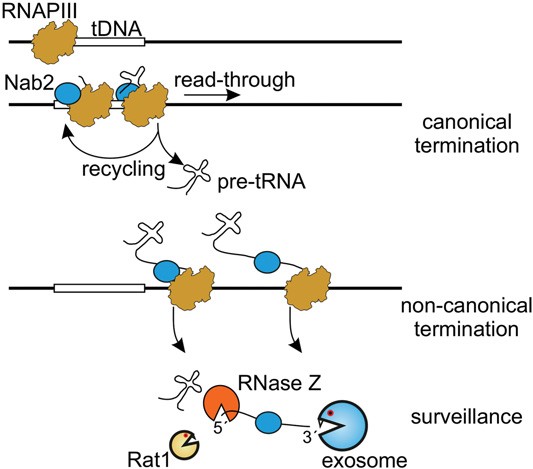 Now, following complicated lab procedures, geneticists from Edinburgh and Warsaw have observed interesting phenomena among tRNA genes that sometimes generate long, 3'-extended forms by read-through of the canonical poly(U) terminators. They propose that the genes have "housekeeping" roles, sustained at the proper level "due to targeting by the nuclear surveillance machinery." We see here more evidence for robust software management.
Now, following complicated lab procedures, geneticists from Edinburgh and Warsaw have observed interesting phenomena among tRNA genes that sometimes generate long, 3'-extended forms by read-through of the canonical poly(U) terminators. They propose that the genes have "housekeeping" roles, sustained at the proper level "due to targeting by the nuclear surveillance machinery." We see here more evidence for robust software management.
 Global analysis of transcriptionally engaged yeast RNA polymerase III reveals extended tRNA transcripts by Tomasz W. Turowski et al., doi:10.1101/gr.205492.116, Genome Res., online 20 May 2016. Global analysis of transcriptionally engaged yeast RNA polymerase III reveals extended tRNA transcripts by Tomasz W. Turowski et al., doi:10.1101/gr.205492.116, Genome Res., online 20 May 2016.
 Introns... is a related webpage. Introns... is a related webpage.
 Viruses... is all about HGT. Viruses... is all about HGT.
 Diversity-generating retroelements...., 28 Apr 2015. Diversity-generating retroelements...., 28 Apr 2015.
 Recipient-initiated horizontal gene transfer, 7 Jul 2014. Recipient-initiated horizontal gene transfer, 7 Jul 2014.
 Gene Conversion is a topic under "Why Sexual Reproduction?" Gene Conversion is a topic under "Why Sexual Reproduction?"
 Robust Software Management... is a new, incomplete webpage. Robust Software Management... is a new, incomplete webpage.
 Bacteria perfected protein complexes more than 3.5 billion years ago, ScienceDaily, 09 Jun 2016, re: Bacteria perfected protein complexes more than 3.5 billion years ago, ScienceDaily, 09 Jun 2016, re:
 Ancestral Tryptophan Synthase Reveals Functional Sophistication of Primordial Enzyme Complexes by Florian Busch et al., dio:10.1016/j.chembiol.2016.05.009, Cell Chemical Biology, online 09 Jun 2016. Ancestral Tryptophan Synthase Reveals Functional Sophistication of Primordial Enzyme Complexes by Florian Busch et al., dio:10.1016/j.chembiol.2016.05.009, Cell Chemical Biology, online 09 Jun 2016.
 Thanks, Martin Langford, who writes, Early complexity supports panspermia.... Thanks, Martin Langford, who writes, Early complexity supports panspermia....
 Metazoan Genes Older Than Metazoa? and Metazoan Genes Older Than Metazoa? and
 Genes Older Than Earth? are related local webpages. Genes Older Than Earth? are related local webpages.
Meteorites contain evidence for extraterrestrial life, in spite of earthly contamination, writes Richard Hoover,
 Meteorite Contamination and "The Dog that Didn't Bark" [docx | pdf], from Moscow, 13 Jun 2016. Meteorite Contamination and "The Dog that Didn't Bark" [docx | pdf], from Moscow, 13 Jun 2016.
 Amino Acid Asymmetry..., Amino Acid Asymmetry...,  ...Indigenous Microfossils..., ...Indigenous Microfossils...,
 Fossilized bacteria..., Fossilized bacteria...,  ...Indigenous Microfossils... and ...Indigenous Microfossils... and
 Contaminated Meteorite are some related local entries. Contaminated Meteorite are some related local entries.
When we looked at the existing Earth-bound theories of the origin of life it slowly dawned on us that such ideas have very little to support them —
Chandra Wickramasinghe on his collaboration with Fred Hoyle
 Interview with Anushree Srivastava for IARC, Centre for United Nations, Jun 2016.
Interview with Anushree Srivastava for IARC, Centre for United Nations, Jun 2016.
 ...Analysis of Interstellar Dust and ...Analysis of Interstellar Dust and
 Fred Hoyle: Interviewed... have some background about the collaboration. Fred Hoyle: Interviewed... have some background about the collaboration.
...Nucleic acids are composed of only d [right-handed] sugars. ...In multiple meteorites, we demonstrate that rare and common sugar acids contain large excesses of the d enantiomer. The consensus is to suppose that some unknown process in space favored the biological enantiomer of these chiral molecules, thus providing suitable ingredients for a pre-biotic soup on Earth. But, as Chemistry World observes, The origin of sugars' and amino acids' homochirality is still a mystery. We suggest that these ones (and the left-handed amino acids) found in meteorites might well be post-biotic.
 Enantiomer excesses of rare and common sugar derivatives in carbonaceous meteorites by George Cooper and Andro C. Rios, doi:10.1073/pnas.1603030113, PNAS, online 31 May 2016. Enantiomer excesses of rare and common sugar derivatives in carbonaceous meteorites by George Cooper and Andro C. Rios, doi:10.1073/pnas.1603030113, PNAS, online 31 May 2016.
 Meteorite compounds hint at origins of life's asymmetry by Emma Stoye, Chemistry World, 31 May 2016. Meteorite compounds hint at origins of life's asymmetry by Emma Stoye, Chemistry World, 31 May 2016.
 Amino Acid Asymmetry in the Murchison Meteorite! is a related local webpage. Amino Acid Asymmetry in the Murchison Meteorite! is a related local webpage.
 Thanks, Richard Hoover. Thanks, Richard Hoover.
| 03 Jun 2016 |
What'sNEW about HGT  | | |
...The mutation event giving rise to industrial melanism in Britain was the insertion of a large [21,925 nucleotides], tandemly repeated, transposable element into the first intron of the gene cortex....
 The insert was found to be present in 105 out of 110 fully black moths (wild caught in the UK since 2002) and absent in all (283) typica tested.... The insert was found to be present in 105 out of 110 fully black moths (wild caught in the UK since 2002) and absent in all (283) typica tested....
 The probability density for the date of the carb-TE mutation event is highly skewed ...with a maximum likelihood at 1819, a date highly consistent with a detectable frequency being achieved in the mid-1840s. The probability density for the date of the carb-TE mutation event is highly skewed ...with a maximum likelihood at 1819, a date highly consistent with a detectable frequency being achieved in the mid-1840s.
 The carb-TE is a spectacular example of an adaptively advantageous transposon; its discovery fills a fundamental gap in the peppered moth story and furthers our appreciation of the mechanism underpinning rapid adaptation. A consensus on the general importance of transposable elements for adaptive evolution has yet to emerge. Over longer time frames, phenotypic effects of transposable elements may be obscured by imprecise excision that leaves a minimal trace of the transposable element while retaining the mutant (adaptive) phenotype. By contrast, we have shown that the carb-TE is young, approximately 200 years (generations) old, during which time it has gone from a single mutation to near fixation (regionally) to near extinction-driven by a pulse of environmental change. The carb-TE is a spectacular example of an adaptively advantageous transposon; its discovery fills a fundamental gap in the peppered moth story and furthers our appreciation of the mechanism underpinning rapid adaptation. A consensus on the general importance of transposable elements for adaptive evolution has yet to emerge. Over longer time frames, phenotypic effects of transposable elements may be obscured by imprecise excision that leaves a minimal trace of the transposable element while retaining the mutant (adaptive) phenotype. By contrast, we have shown that the carb-TE is young, approximately 200 years (generations) old, during which time it has gone from a single mutation to near fixation (regionally) to near extinction-driven by a pulse of environmental change.
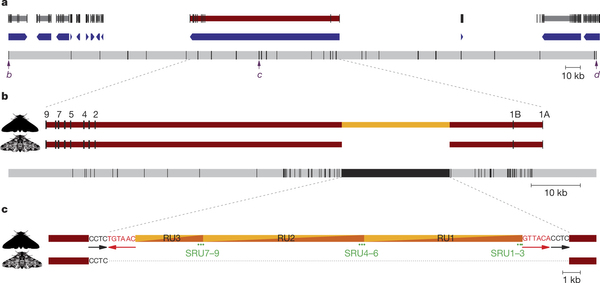 The report begins, "Disovering the mutational events that fuel adaptation to environmental change remains an important challenge for evolutionary biology. The classroom example of a visible evolutionary response is industrial melanism in the peppered moth (Biston betularia): the replacement, during the Industrial Revolution, of the common pale typica form by a previously unknown black (carbonaria) form, driven by the interaction between bird predation and coal pollution." Now we see that the dark variant emerged following the precise insertion of a specific large transposable element into a certain gene. This phenomenon supports cosmic ancestry and surprises standard darwinism. Coming from the peppered moth, beloved by darwinists, the example is especially ironic.
The report begins, "Disovering the mutational events that fuel adaptation to environmental change remains an important challenge for evolutionary biology. The classroom example of a visible evolutionary response is industrial melanism in the peppered moth (Biston betularia): the replacement, during the Industrial Revolution, of the common pale typica form by a previously unknown black (carbonaria) form, driven by the interaction between bird predation and coal pollution." Now we see that the dark variant emerged following the precise insertion of a specific large transposable element into a certain gene. This phenomenon supports cosmic ancestry and surprises standard darwinism. Coming from the peppered moth, beloved by darwinists, the example is especially ironic.
 The industrial melanism mutation in British peppered moths is a transposable element by Arjen E. van't Hof, Pascal Campagne et al., doi:10.1038/nature17951, p 102-105 v 534, Nature, 02 Jun 2016. The industrial melanism mutation in British peppered moths is a transposable element by Arjen E. van't Hof, Pascal Campagne et al., doi:10.1038/nature17951, p 102-105 v 534, Nature, 02 Jun 2016.
 'Jumping gene' took peppered moths to the dark side, University of Liverpool (+Newswise), 01 Jun 2016. 'Jumping gene' took peppered moths to the dark side, University of Liverpool (+Newswise), 01 Jun 2016.
 'Landmark study' solves mystery behind classic evolution story by Emily Benson, Science, 01 Jun 2016. 'Landmark study' solves mystery behind classic evolution story by Emily Benson, Science, 01 Jun 2016.
 Viruses and Other Gene Transfer Mechanisms and Viruses and Other Gene Transfer Mechanisms and
 Neo-Darwinism... are related local webpages. Neo-Darwinism... are related local webpages.
 email from Theodore Rigley prompts related discussion, 04 Jun 2016. email from Theodore Rigley prompts related discussion, 04 Jun 2016.
| 01 Jun 2016 |
What'sNEW about HGT  | | |
 In the course of evolution, genes of gut microbes "jumped" to their insect host, Max Planck Institute for Chemical Ecology (+ScienceDaily), 31 May 2016. In the course of evolution, genes of gut microbes "jumped" to their insect host, Max Planck Institute for Chemical Ecology (+ScienceDaily), 31 May 2016.
 Thanks, Google Alerts. Thanks, Google Alerts.
 Horizontal gene transfer of pectinases from bacteria preceded the diversification of stick and leaf insects by Matan Shelomi et al., doi:10.1038/srep26388, Scientific Reports, 23 May 2016. Horizontal gene transfer of pectinases from bacteria preceded the diversification of stick and leaf insects by Matan Shelomi et al., doi:10.1038/srep26388, Scientific Reports, 23 May 2016.
 Viruses and Other Gene Transfer Mechanisms is a related local webpage. Viruses and Other Gene Transfer Mechanisms is a related local webpage.
 Comet 67P atmosphere contains chemicals of life, Rosetta mission finds by Nicola Davis, The Guardian, 27 May 2016. Comet 67P atmosphere contains chemicals of life, Rosetta mission finds by Nicola Davis, The Guardian, 27 May 2016.
 Rosetta's comet contains ingredients for life, ESA, 27 May 2016. Rosetta's comet contains ingredients for life, ESA, 27 May 2016.
 Prebiotic chemicals–amino acid and phosphorus–in the coma of comet 67P/Churyumov-Gerasimenko by Kathrin Altwegg et al., doi:10.1126/sciadv.1600285, Science Advances, 27 May 2016. Prebiotic chemicals–amino acid and phosphorus–in the coma of comet 67P/Churyumov-Gerasimenko by Kathrin Altwegg et al., doi:10.1126/sciadv.1600285, Science Advances, 27 May 2016.
 What'sNEW under "Comet Rendezvous" has more links about Rosetta. What'sNEW under "Comet Rendezvous" has more links about Rosetta.
 Thanks, George Nickas, Stan Franklin, Adam Klyce, Vitaly Mats and Steve Pike. Thanks, George Nickas, Stan Franklin, Adam Klyce, Vitaly Mats and Steve Pike.
The delayed recognition of the gene ...had a strange consequence: genetics had to be reconciled with the other major fields of biology as an afterthought. — Siddhartha Mukherjee,
 The Gene: An Intimate History, Scribner, May 2016. The Gene: An Intimate History, Scribner, May 2016.
 Censorship & Upcoming Royal Society Evo Meeting by Suzan Mazur, Huffpost Science, 25 May 2016. Censorship & Upcoming Royal Society Evo Meeting by Suzan Mazur, Huffpost Science, 25 May 2016.
| 25 May 2016 |
What'sNEW about HGT  | | |
...We suggest that the expanding database of closely related eukaryotic genomes and the application of novel analytic methods will further underline the significant impact of foreign gene acquisition across the tree of life.
 Extensive horizontal gene transfers between plant pathogenic fungi by Huan Qiu et al., doi:10.1186/s12915-016-0264-3, BMC Biology, 23 May 2016. Extensive horizontal gene transfers between plant pathogenic fungi by Huan Qiu et al., doi:10.1186/s12915-016-0264-3, BMC Biology, 23 May 2016.
 Thanks, Google Alerts. Thanks, Google Alerts.
 Viruses and Other Gene Transfer Mechanisms is a related local webpage. Viruses and Other Gene Transfer Mechanisms is a related local webpage.
A report of contamination in the Orgueil meteorite severely hindered the study of meteorites for forty years. Of course, biological contaminants are everywhere and meteoriticists must use care to exclude them and precise methods to discern them. But the report by Anders et al., in 1964, was likely a complete fraud on science.
 email from Richard Hoover has more, with links, 18 May 2016. email from Richard Hoover has more, with links, 18 May 2016.
 Comets... has background information. Comets... has background information.
 Fossilized Magnetotactic Bacterium in the Orgueil Meteorite describes more evidence from the same meteorite. Fossilized Magnetotactic Bacterium in the Orgueil Meteorite describes more evidence from the same meteorite.
| 13 May 2016 |
What'sNEW about HGT  | | |
Yeast likely acquired the gene for an essential protein via horizontal gene transfer.
 The protein, SBF, controls the expression of genes that are needed to begin the cell cycle, but it is different from the corresponding one in plants and animals. After an extensive phylogenetic-based classification of protein homologs, a team at Duke University concluded that fungi acquired SBF via a DNA virus.
The protein, SBF, controls the expression of genes that are needed to begin the cell cycle, but it is different from the corresponding one in plants and animals. After an extensive phylogenetic-based classification of protein homologs, a team at Duke University concluded that fungi acquired SBF via a DNA virus.
 Punctuated evolution and transitional hybrid network in an ancestral cell cycle of fungi by Edgar M Medina et al., doi:10.7554/eLife.09492, eLife, online 10 May 2016; and commentary: Punctuated evolution and transitional hybrid network in an ancestral cell cycle of fungi by Edgar M Medina et al., doi:10.7554/eLife.09492, eLife, online 10 May 2016; and commentary:
 Hijacked Cell Division Helped Fuel Rise of Fungi by Robin A. Smith, Duke University (+ScienceDaily), 9-10 May 2016. Hijacked Cell Division Helped Fuel Rise of Fungi by Robin A. Smith, Duke University (+ScienceDaily), 9-10 May 2016.
 Viruses and Other Gene Transfer Mechanisms has links to many more examples. Viruses and Other Gene Transfer Mechanisms has links to many more examples.
 Thanks, Martin Langford. Thanks, Martin Langford.
The genome of Chlamydomonas, a well-studied model organism, contains ~1000 blocks of unknown sequence. New research reveals that a substantial proportion of them contain hidden exons. These exons represent de novo sequence generally present nowhere in the previously assembled genome. We note that functional genetic sequences like these,with no apparent darwinian origin or purpose, surprise darwinists and support cosmic ancestry.
 Patching Holes in the Chlamydomonas Genome by Frej Tulin and Frederick R. Cross, doi:10.1534/g3.116.029207, G3, online 10 May 2016. Patching Holes in the Chlamydomonas Genome by Frej Tulin and Frederick R. Cross, doi:10.1534/g3.116.029207, G3, online 10 May 2016.
 Conserved Non-Genic Sequences is a related webpage. Conserved Non-Genic Sequences is a related webpage.
 Boiling water on Mars could explain seasonal wet streaks, doi:10.1126/science.aaf5680, Science, 2 May 2016. Boiling water on Mars could explain seasonal wet streaks, doi:10.1126/science.aaf5680, Science, 2 May 2016.
 Martian water on the boil, doi:10.1038/533011b, Nature, 4 May 2016. Martian water on the boil, doi:10.1038/533011b, Nature, 4 May 2016.
 Life on Mars! is the related webpage. Life on Mars! is the related webpage.
| 30 Apr 2016 |
What'sNEW about HGT  | | |
Interestingly, an emerging theme throughout the evolution of multicellularity is that the genetic basis for the evolutionary transition emerges much earlier than anticipated....
 The Gonium pectorale genome demonstrates co-option of cell cycle regulation during the evolution of multicellularity by Erik R. Hanschen et al., doi:10.1038/ncomms11370, Nature Communications, 22 Apr 2016. The Gonium pectorale genome demonstrates co-option of cell cycle regulation during the evolution of multicellularity by Erik R. Hanschen et al., doi:10.1038/ncomms11370, Nature Communications, 22 Apr 2016.
 Metazoan Genes Older Than Metazoa? and Metazoan Genes Older Than Metazoa? and
 Genes Older Than Earth? have more about genetic programs appearing much earlier than anticipated by darwinism. Genes Older Than Earth? have more about genetic programs appearing much earlier than anticipated by darwinism.
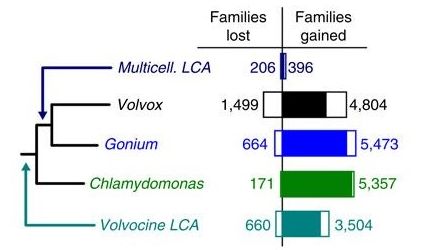 And, in the accompanying phylogenetic analysis of gene family evolution (right), bars to the left and right of the vertical axis denote the lost and gained gene families, respectively, relative to its parental node. Thus, the research also supports our contention that evolutionary advances come when whole genetic programs are acquired.
And, in the accompanying phylogenetic analysis of gene family evolution (right), bars to the left and right of the vertical axis denote the lost and gained gene families, respectively, relative to its parental node. Thus, the research also supports our contention that evolutionary advances come when whole genetic programs are acquired.
 Viruses and Other Gene Transfer Mechanisms has more about how whole genetic programs are acquired by HGT. Viruses and Other Gene Transfer Mechanisms has more about how whole genetic programs are acquired by HGT.
 For many evolutionary biologists, nothing gets their dander up faster than proposing that evolution is anything other than the process of natural selection, acting on random mutations. Suggestions that something is missing from that picture ...play into the hands of creationists, who leap on them as evidence against evolution itself.
For many evolutionary biologists, nothing gets their dander up faster than proposing that evolution is anything other than the process of natural selection, acting on random mutations. Suggestions that something is missing from that picture ...play into the hands of creationists, who leap on them as evidence against evolution itself.
 Templeton grant funds evolution rethink by Elizabeth Pennisi, v 352 p 394, Science, 22 Apr 2016. Templeton grant funds evolution rethink by Elizabeth Pennisi, v 352 p 394, Science, 22 Apr 2016.
 Evolution versus Creationism has more about the gridlock created by the two camps. Evolution versus Creationism has more about the gridlock created by the two camps.
Genetic programs that predate the features they encode are being observed too often to ignore. Usually, the researchers who discover them begin with an unrelated goal and hardly remark on the anomaly of genetic systems or programming that somehow bypassed the required darwinian trial-and-error stage. For example:
 Cis-regulatory architecture of a brain signaling center predates the origin of chordates by Yao Yao et al., doi:10.1038/ng.3542, Nature Genetics, online 11 Apr 2016. Cis-regulatory architecture of a brain signaling center predates the origin of chordates by Yao Yao et al., doi:10.1038/ng.3542, Nature Genetics, online 11 Apr 2016.
 Metazoan Genes Older Than Metazoa? lists over two hundred examples we have noticed since 1996, like the one four days ago, next below. Metazoan Genes Older Than Metazoa? lists over two hundred examples we have noticed since 1996, like the one four days ago, next below.
 Genes Older Than Earth? is a local webpage with a radical suggestion. Genes Older Than Earth? is a local webpage with a radical suggestion.
A defining feature of multicellular animals is their capacity to generate multiple specialized cell types through temporally and spatially regulated developmental programs. These programs of individual cell differentiation involve the generation of cell-specific transcriptional profiles. Recent genomic analyses, however, have shown that the unicellular ancestor of Metazoa already had a complex gene repertoire involved in multicellular functions, including specific differentiation programs.... Gene repertoires that exist before the appearance on Earth of the features they encode confound standard darwinism and confirm cosmic ancestry.
 The Dynamic Regulatory Genome of Capsaspora and the Origin of Animal Multicellularity by Arnau Sebé-Pedrós et al., doi:10.1016/j.cell.2016.03.034, Cell, 21 Apr 2016. The Dynamic Regulatory Genome of Capsaspora and the Origin of Animal Multicellularity by Arnau Sebé-Pedrós et al., doi:10.1016/j.cell.2016.03.034, Cell, 21 Apr 2016.
 Evolution: Gene regulation in transition by David S. Booth and Nicole King, doi:10.1038/nature18447, Nature, 23 Jun 2016. ...Many 'animal' genes pre-date animal origins. Evolution: Gene regulation in transition by David S. Booth and Nicole King, doi:10.1038/nature18447, Nature, 23 Jun 2016. ...Many 'animal' genes pre-date animal origins.
 Metazoan Genes Older Than Metazoa? and Metazoan Genes Older Than Metazoa? and
 Genes Older Than Earth? are related local webpages. Genes Older Than Earth? are related local webpages.

 Interstellar grains seen by the Cassini spacecraft lend support to the old panspermia hypothesis by astrobiologist Dirk Schulze-Makuch (pictured), AirSpaceMag.com, 21 Apr 2016. Interstellar grains seen by the Cassini spacecraft lend support to the old panspermia hypothesis by astrobiologist Dirk Schulze-Makuch (pictured), AirSpaceMag.com, 21 Apr 2016.
 Most interstellar particles captured by Stardust are complex organic compounds, 27 Apr 2000. Most interstellar particles captured by Stardust are complex organic compounds, 27 Apr 2000.
 Hoyle and Wickramasinghe's Analysis of Interstellar Dust is a related local webpage. Hoyle and Wickramasinghe's Analysis of Interstellar Dust is a related local webpage.
...You need sceptics especially when the science gets very big and monolithic — James Lovelock interviewed by Leo Hickman, The Guardian, 29 Mar 2010.
 Gaia has more about Lovelock. Gaia has more about Lovelock.
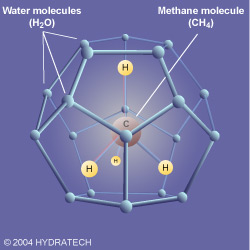 ...Our results provide a strong argument for the presence of CH4 and C2H6 clathrates in the nucleus of 67P. On Earth, methane (CH4) comes from life, and ethane (C2H6) comes from methane. Underwater sediments and frozen soils around our planet contain abundant methane clathrates — lattices of water molecules with methane and related organics trapped inside. Now the Rosetta mission enables us to see evidence that comet 67P also has them. Microbial life may have produced the methane and resulting ethane found there as well.
...Our results provide a strong argument for the presence of CH4 and C2H6 clathrates in the nucleus of 67P. On Earth, methane (CH4) comes from life, and ethane (C2H6) comes from methane. Underwater sediments and frozen soils around our planet contain abundant methane clathrates — lattices of water molecules with methane and related organics trapped inside. Now the Rosetta mission enables us to see evidence that comet 67P also has them. Microbial life may have produced the methane and resulting ethane found there as well.
 The presence of clathrates in comet 67P/Churyumov-Gerasimenko by Adrienn Luspay-Kuti, doi:10.1126/sciadv.1501781, Science Advances, 08 Apr 2016. The presence of clathrates in comet 67P/Churyumov-Gerasimenko by Adrienn Luspay-Kuti, doi:10.1126/sciadv.1501781, Science Advances, 08 Apr 2016.
 Water ice, but what kind? Evidence for clathrates in 67P by Adrienn Luspay-Kuti, NASA, JPL, 19 Apr 2016. Water ice, but what kind? Evidence for clathrates in 67P by Adrienn Luspay-Kuti, NASA, JPL, 19 Apr 2016.
 Comets: The Delivery System is a related local webpage. Comets: The Delivery System is a related local webpage.
 What'sNEW under "Comet Rendezvous" has all our links about Rosetta. What'sNEW under "Comet Rendezvous" has all our links about Rosetta.
One of the several ways in which microbiology puts the neo-Darwinian synthesis in jeopardy is by the threatening to "uproot the Tree of Life". Lateral gene transfer is much more frequent than most biologists would have imagined up until about 20 years ago.... — W. Ford Doolittle and Tyler D. P. Brunet,
 What Is the Tree of Life?, doi:10.1371/journal.pgen.1005912, PLoS Genet, 14 Apr 2016. What Is the Tree of Life?, doi:10.1371/journal.pgen.1005912, PLoS Genet, 14 Apr 2016.
 The Tree of Life has links to more under
What'sNEW there. The Tree of Life has links to more under
What'sNEW there.
 Researchers at the Lima-based International Potato Center and scientists at the National Aeronautics and Space Administration are studying which type of potato could be best suited for extraterrestrial farming to support a human settlement on Mars. The Pampas de La Joya Desert in southern Peru (pictured) has soil conditions like Mars.
Researchers at the Lima-based International Potato Center and scientists at the National Aeronautics and Space Administration are studying which type of potato could be best suited for extraterrestrial farming to support a human settlement on Mars. The Pampas de La Joya Desert in southern Peru (pictured) has soil conditions like Mars.
 NASA Really Is Trying to Grow Potatoes on Mars by Ryan Dube, The Wall Street Journal, 12 Apr 2016. NASA Really Is Trying to Grow Potatoes on Mars by Ryan Dube, The Wall Street Journal, 12 Apr 2016.
 Can Plants Grow with Mars Soil?, Gary Jordan, ed., NASA Johnson Space Center, updated 15 Oct 2015. Can Plants Grow with Mars Soil?, Gary Jordan, ed., NASA Johnson Space Center, updated 15 Oct 2015.
 Life on Mars! is the related local webpage. Life on Mars! is the related local webpage.
| 12 Apr 2016 |
What'sNEW about HGT  | | |
 Horizontally acquired genes in early-diverging pathogenic fungi enable the use of host nucleosides and nucleotides, William G. Alexander et al., doi:10.1073/pnas.1517242113, PNAS, 12 Apr 2016. Horizontally acquired genes in early-diverging pathogenic fungi enable the use of host nucleosides and nucleotides, William G. Alexander et al., doi:10.1073/pnas.1517242113, PNAS, 12 Apr 2016.
 Viruses and Other Gene Transfer Mechanisms has related information and links. Viruses and Other Gene Transfer Mechanisms has related information and links.
 Diverse microbial life thrives in aquifers under the deep ocean floor. A team at the Marine Biological Laboratory reports, The 16S rRNA and 16S rRNA gene amplicon sequencing from crustal fluids, seawater, and drilling mud, together with the metagenomic analysis of select samples, revealed a diverse microbial community in the North Pond crustal fluids that is distinct from deep seawater communities. Water pressure at the deepest tested depth would be ~500 atmospheres. We suspect such life could flourish in similar deep dark underwater environments on other planets or moons.
Diverse microbial life thrives in aquifers under the deep ocean floor. A team at the Marine Biological Laboratory reports, The 16S rRNA and 16S rRNA gene amplicon sequencing from crustal fluids, seawater, and drilling mud, together with the metagenomic analysis of select samples, revealed a diverse microbial community in the North Pond crustal fluids that is distinct from deep seawater communities. Water pressure at the deepest tested depth would be ~500 atmospheres. We suspect such life could flourish in similar deep dark underwater environments on other planets or moons.
 A distinct and active bacterial community in cold oxygenated fluids circulating beneath the western flank of the Mid-Atlantic ridge by Julie L. Meyer et al., doi: 10.1038/srep22541, Sci. Rep., online 03 Mar 2016. A distinct and active bacterial community in cold oxygenated fluids circulating beneath the western flank of the Mid-Atlantic ridge by Julie L. Meyer et al., doi: 10.1038/srep22541, Sci. Rep., online 03 Mar 2016.
 How deep does life go? by Diana Kenney, Marine Biological Laboratory (+EurekAlert), 06 Apr 2016. How deep does life go? by Diana Kenney, Marine Biological Laboratory (+EurekAlert), 06 Apr 2016.
 Bacteria... has more about the capability of prokaryotes to persist and even thrive in all manner of harsh environments. Bacteria... has more about the capability of prokaryotes to persist and even thrive in all manner of harsh environments.
 Life on Europa...? has links about moons of Jupiter and Saturn with deep, ice-covered oceans. Life on Europa...? has links about moons of Jupiter and Saturn with deep, ice-covered oceans.
| 09 Apr 2016 |
What'sNEW about HGT  | | |
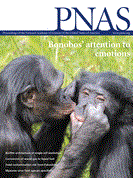 The human reference genome contains over 120 HML-2 [endogenous retrovirus] insertions that are not present in chimpanzees, bonobos, or gorillas.
The human reference genome contains over 120 HML-2 [endogenous retrovirus] insertions that are not present in chimpanzees, bonobos, or gorillas.
 Discovery of unfixed endogenous retrovirus insertions in diverse human populations Julia Halo Wildschutte, Zachary H. Williams et al., doi:10.1073/pnas.1602336113; and commentary by Jack Lenz, PNAS, 19 Apr 2016. Discovery of unfixed endogenous retrovirus insertions in diverse human populations Julia Halo Wildschutte, Zachary H. Williams et al., doi:10.1073/pnas.1602336113; and commentary by Jack Lenz, PNAS, 19 Apr 2016.
 Human Genome Search discusses a relevant research project. Human Genome Search discusses a relevant research project.
 New genetic programs in Darwinism and strong panspermia suggests how this news may support cosmic ancestry. New genetic programs in Darwinism and strong panspermia suggests how this news may support cosmic ancestry.
 Viruses and Other Gene Transfer Mechanisms has related information and links. Viruses and Other Gene Transfer Mechanisms has related information and links.
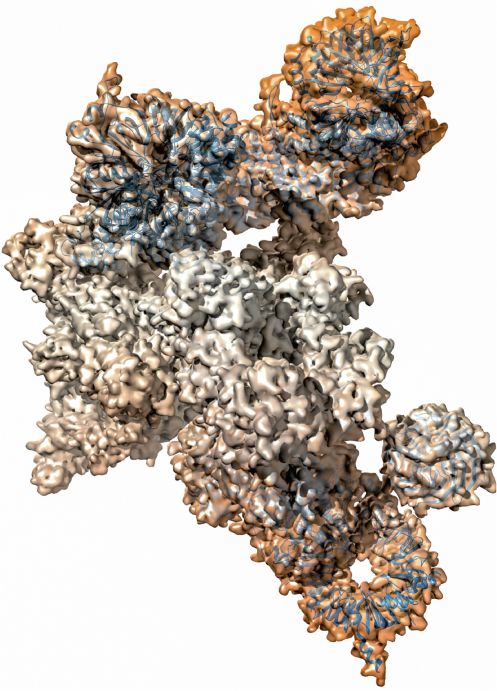
Ribbon diagram representations of some of the molecular components of the U4/U6.U5 triple small nuclear ribonucleoprotein (tri-snRNP) complex are shown within the cryo-EM structure.
|
The first molecular-resolution reconstruction of a central assembly of the human spliceosome is reported by a team using cryo-electron microscopy at Max Planck Institute and its affiliates in Göttingen, Germany. The splicesome is a complex of proteins and ribozymes that splices introns out of pre-mRNA, before the edited mRNA can be properly translated in a ribosome. This splicing "is both a highly complex and highly regulated process, and gives a single gene the potential to encode many different protein variants with different properties and functions."
"The recent structural models of the spliceosome in different steps of the splicing reaction represent a turning point for the field, reminiscent of the change that occurred when structures of the protein-synthesizing machine—the ribosome—were resolved in 2000.... Now, dozens of ribosome and ribosomal subunit structures are determined every year. With the advent of high-resolution cryo-EM, the same is likely to be true for the spliceosome over the next decade."
As this exploration proceeds, one would expect to notice abundant corroboration for the standard theory of evolution. So far, we don't see it. The human splicesome has some components closely orthologous to those in yeast, and others that look wholly different. Either way, the complex mechanisms and the lengthy programs behind them have no plausible, reconstructable origin, as darwinism would require.
In cosmic ancestry, splicing and editing are essential for evolution. Instead of how, we wonder if they originated. Without the big bang, what's the evidence?
 Molecular architecture of the human U4/U6.U5 tri-snRNP by Dmitry E. Agafonov, Berthold Kastner, Olexandr Dybkov et al., doi:10.1126/science.aad2085; and commentary:
A Big Bang in spliceosome structural biology by Jamie H. D. Cate, v 351, Science, 25 Mar 2016. Molecular architecture of the human U4/U6.U5 tri-snRNP by Dmitry E. Agafonov, Berthold Kastner, Olexandr Dybkov et al., doi:10.1126/science.aad2085; and commentary:
A Big Bang in spliceosome structural biology by Jamie H. D. Cate, v 351, Science, 25 Mar 2016.
 Introns... is the main related local webage. Introns... is the main related local webage.
![]()
|
 The protein, SBF, controls the expression of genes that are needed to begin the cell cycle, but it is different from the corresponding one in plants and animals. After an extensive phylogenetic-based classification of protein homologs, a team at Duke University concluded that fungi acquired SBF via a DNA virus.
The protein, SBF, controls the expression of genes that are needed to begin the cell cycle, but it is different from the corresponding one in plants and animals. After an extensive phylogenetic-based classification of protein homologs, a team at Duke University concluded that fungi acquired SBF via a DNA virus. And, in the accompanying phylogenetic analysis of gene family evolution (right), bars to the left and right of the vertical axis denote the lost and gained gene families, respectively, relative to its parental node. Thus, the research also supports our contention that evolutionary advances come when whole genetic programs are acquired.
And, in the accompanying phylogenetic analysis of gene family evolution (right), bars to the left and right of the vertical axis denote the lost and gained gene families, respectively, relative to its parental node. Thus, the research also supports our contention that evolutionary advances come when whole genetic programs are acquired. For many evolutionary biologists, nothing gets their dander up faster than proposing that evolution is anything other than the process of natural selection, acting on random mutations. Suggestions that something is missing from that picture ...play into the hands of creationists, who leap on them as evidence against evolution itself.
For many evolutionary biologists, nothing gets their dander up faster than proposing that evolution is anything other than the process of natural selection, acting on random mutations. Suggestions that something is missing from that picture ...play into the hands of creationists, who leap on them as evidence against evolution itself.

 ...Our results provide a strong argument for the presence of CH4 and C2H6 clathrates in the nucleus of 67P. On Earth, methane (CH4) comes from life, and ethane (C2H6) comes from methane. Underwater sediments and frozen soils around our planet contain abundant methane clathrates — lattices of water molecules with methane and related organics trapped inside. Now the Rosetta mission enables us to see evidence that comet 67P also has them. Microbial life may have produced the methane and resulting ethane found there as well.
...Our results provide a strong argument for the presence of CH4 and C2H6 clathrates in the nucleus of 67P. On Earth, methane (CH4) comes from life, and ethane (C2H6) comes from methane. Underwater sediments and frozen soils around our planet contain abundant methane clathrates — lattices of water molecules with methane and related organics trapped inside. Now the Rosetta mission enables us to see evidence that comet 67P also has them. Microbial life may have produced the methane and resulting ethane found there as well.

 Diverse microbial life thrives in aquifers under the deep ocean floor. A team at the Marine Biological Laboratory reports, The 16S rRNA and 16S rRNA gene amplicon sequencing from crustal fluids, seawater, and drilling mud, together with the metagenomic analysis of select samples, revealed a diverse microbial community in the North Pond crustal fluids that is distinct from deep seawater communities. Water pressure at the deepest tested depth would be ~500 atmospheres. We suspect such life could flourish in similar deep dark underwater environments on other planets or moons.
Diverse microbial life thrives in aquifers under the deep ocean floor. A team at the Marine Biological Laboratory reports, The 16S rRNA and 16S rRNA gene amplicon sequencing from crustal fluids, seawater, and drilling mud, together with the metagenomic analysis of select samples, revealed a diverse microbial community in the North Pond crustal fluids that is distinct from deep seawater communities. Water pressure at the deepest tested depth would be ~500 atmospheres. We suspect such life could flourish in similar deep dark underwater environments on other planets or moons.
 The human reference genome contains over 120 HML-2 [endogenous retrovirus] insertions that are not present in chimpanzees, bonobos, or gorillas.
The human reference genome contains over 120 HML-2 [endogenous retrovirus] insertions that are not present in chimpanzees, bonobos, or gorillas.
 Now, following complicated lab procedures, geneticists from Edinburgh and Warsaw have observed interesting phenomena among tRNA genes that sometimes generate long, 3'-extended forms by read-through of the canonical poly(U) terminators. They propose that the genes have "housekeeping" roles, sustained at the proper level "due to targeting by the nuclear surveillance machinery." We see here more evidence for robust software management.
Now, following complicated lab procedures, geneticists from Edinburgh and Warsaw have observed interesting phenomena among tRNA genes that sometimes generate long, 3'-extended forms by read-through of the canonical poly(U) terminators. They propose that the genes have "housekeeping" roles, sustained at the proper level "due to targeting by the nuclear surveillance machinery." We see here more evidence for robust software management.
 The report begins, "Disovering the mutational events that fuel adaptation to environmental change remains an important challenge for evolutionary biology. The classroom example of a visible evolutionary response is industrial melanism in the peppered moth (Biston betularia): the replacement, during the Industrial Revolution, of the common pale typica form by a previously unknown black (carbonaria) form, driven by the interaction between bird predation and coal pollution." Now we see that the dark variant emerged following the precise insertion of a specific large transposable element into a certain gene. This phenomenon supports cosmic ancestry and surprises standard darwinism. Coming from the peppered moth, beloved by darwinists, the example is especially ironic.
The report begins, "Disovering the mutational events that fuel adaptation to environmental change remains an important challenge for evolutionary biology. The classroom example of a visible evolutionary response is industrial melanism in the peppered moth (Biston betularia): the replacement, during the Industrial Revolution, of the common pale typica form by a previously unknown black (carbonaria) form, driven by the interaction between bird predation and coal pollution." Now we see that the dark variant emerged following the precise insertion of a specific large transposable element into a certain gene. This phenomenon supports cosmic ancestry and surprises standard darwinism. Coming from the peppered moth, beloved by darwinists, the example is especially ironic.
